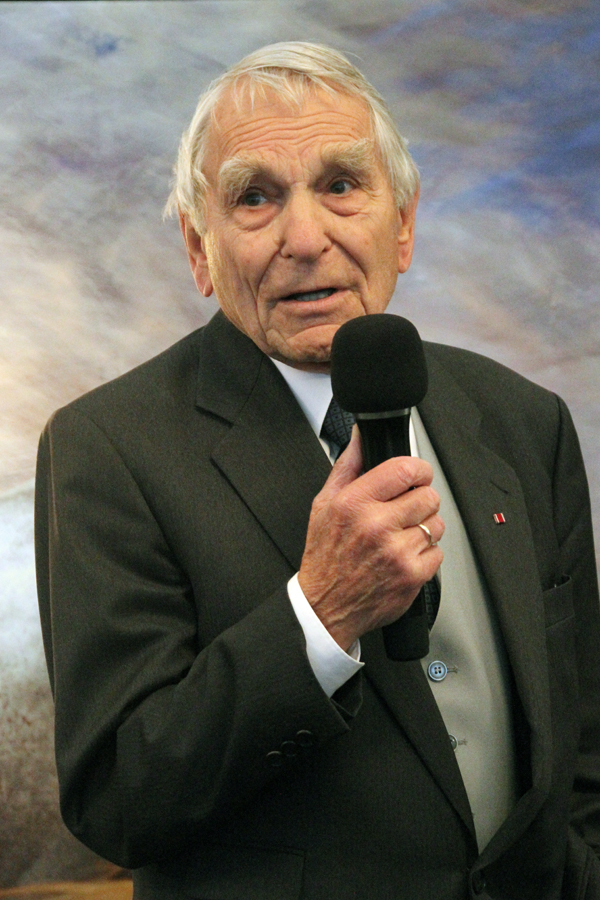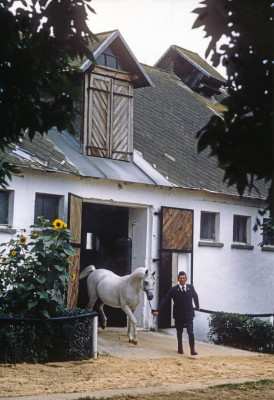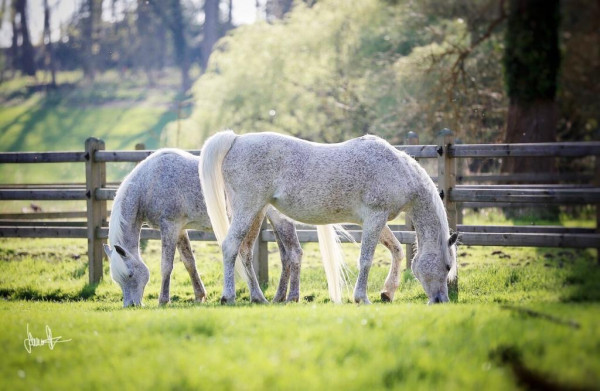50 Years Asil Club: Retrospective and Celebration
by Betty Finke
The world was a different one in 1974, and that includes the world of Arabian horse breeding. It would take another decade for the “industry” to emerge, and globalization was still far ahead in the future. Back then, each country was still doing mostly its own thing. In Europe, showing – and indeed, breeding – was just getting started. But the seeds for the global phenomenon were already laid: in 1970, the World Arabian Horse Organization (WAHO) had been formed, uniting the world’s Arabian registries under one banner. And WAHO has a lot to do with the origins of the Asil Club.
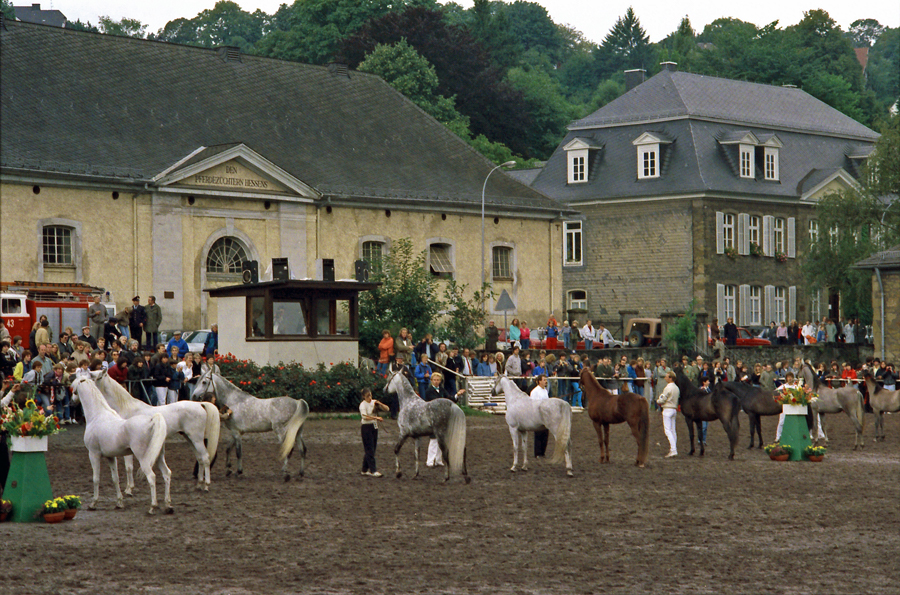 Stallion class at the first Asil Cup show at Dillenburg in 1985.
Stallion class at the first Asil Cup show at Dillenburg in 1985.
The original definition of a purebred Arabian in the world’s stud books had been pretty straightforward: a horse descended in all lines from horses bred in the desert by the Bedouins of Arabia. As obvious as this sounds, there was one little snag: as the song has it, “it ain’t necessarily so.” Arabian breeding in Poland had begun earlier than anywhere else in Europe, and, given Poland’s war-ridden history and shifting borders, much of the early documentation had been lost. As a result, many lines end not in the desert, but with mares that had already been born in Poland and of whom nothing was known but their names. All this was documented and published in the late 1960s by German researcher Ursula Guttmann, a pupil and associate of Carl Raswan’s.
Guttmann’s conclusion that those mares were “native Polish horses” is somewhat rash; that we know nothing about them doesn’t prove they weren’t Arabians. Besides, the Poles clearly accepted them as such. Recent mtDNA research has established that at least one of those dam lines is identical with a proven desert line. But the fact remains that there is no conclusive proof of those horses’ origin, and at least one line does contain some proven non-Arabian (Thoroughbred) blood very far back.
Since the Polish horses, especially Skowronek, formed an integral part of worldwide Arabian breeding, WAHO adjusted its definition of a purebred Arabian to “horses listed in a WAHO-accepted purebred Arabian stud book.” Which, of course, says nothing about purity at all. Everything else was now left to the breeders themselves.
For some of them, this new definition was not good enough. One result was the Blue List in the USA, cataloguing all Arabians who conformed to the original definition, later followed by Al Khamsa. The Asil Club initially was its European cousin.
The founding father of the Asil Club, as well as its chairman up to the present day, is Dr. Georg Olms. In the late 1960s and early 1970s, he imported a group of foundation mares from the USA that combined Babson and Davenport blood with other desertbred sources. These mares were unique in Europe at the time. Sadly, though they produced well, their blood is almost gone today and I know of only one breeder in Germany who still has these horses.
In 1974 then, Dr. Olms, along with several other notable breeders and experts of his day, founded the Asil Club to preserve those horses that could reasonably be assumed to represent 100% desert origins. The Club’s definition was the original one: “An Asil Arabian horse is a horse whose pedigree is exclusively based on horses bred by the Bedouins, without any evidence whatever of non-Arabian blood being admixed at any time. The word ‘asil’ is derived from the Arabian language meaning pure, noble and genuine.” (Asil Arabians, Vol. I)
Unlike the Blue List, however, which was no more than a catalog, the Asil Club focused not only on purity of blood, but also on the unique and particular qualities of the original desert Arabians.
One of its co-founders was Dr. Georg Wenzler, former director of Marbach State Stud and responsible for importing Hadban Enzahi and the other “new” Egyptians to Germany in 1955. In his introduction to the Asil Club’s first documentation in 1977, he wrote: “The Club insists that its members observe the principles of pure breeding. It refuses to give way to sudden fashions and to worship grace and beauty for themselves alone, so as to make the horse a mere object for the show ring. The members understand the Arabian horse to be primarily an excellent riding horse for sporting and recreational purposes and must be bred for performance, otherwise he will degenerate. Continuous performance tests and strict selection are thus indispensable.”
Propagating and promoting these ideas has been a major part of the Asil Club’s work over the years. Dr. Olms is not only a horse breeder, he is the head of an international publishing house based both in Germany and in New York, which gave him the means to go about it professionally. Olms Press already published an equestrian line, the Documenta Hippologica, including facsimiles and reprints of important old books on breeding and equitation. The first Asil Arabian Documentation, from which the quotes above are taken, was published in 1977. It included a selection of quotes on the authentic Arabian horse by experts past and present in German and in English, classic art depicting Arabian horses, many photographs of Asil Arabians with their details and pedigrees, a record of performance achievements by Asil Arabians, and a catalog of the members’ stud farms and their horses. It was followed by another six volumes, each one bigger than the last and more lavishly produced and, beginning with Vol. III, not just in German and English, but in Arabic as well. That first volume, slim and modest by comparison, soon became a much sought-after collector’s item.
 Marbach’s 4-year-old straight Egyptian mare WM Navina (Naoufil x Nagawa) showing her paces at the German registry’s mare inspection.
Marbach’s 4-year-old straight Egyptian mare WM Navina (Naoufil x Nagawa) showing her paces at the German registry’s mare inspection.
 Sahil Ibn Farag II-3 (Farag II-3 x Souha), one of two asil Weil-Marbach stallions currently living.
Sahil Ibn Farag II-3 (Farag II-3 x Souha), one of two asil Weil-Marbach stallions currently living.
 Marbach’s homebred straight Egyptian stallion Naoufil (Mahadin x Namija) with head groom Karin Kollmannsberger.
Marbach’s homebred straight Egyptian stallion Naoufil (Mahadin x Namija) with head groom Karin Kollmannsberger.
 Nasheed Al Amal (Hafez Al Ahd x Aneedah), bred by Philippe Paraskevas in Egypt and now chief sire at Marbach.
Nasheed Al Amal (Hafez Al Ahd x Aneedah), bred by Philippe Paraskevas in Egypt and now chief sire at Marbach.
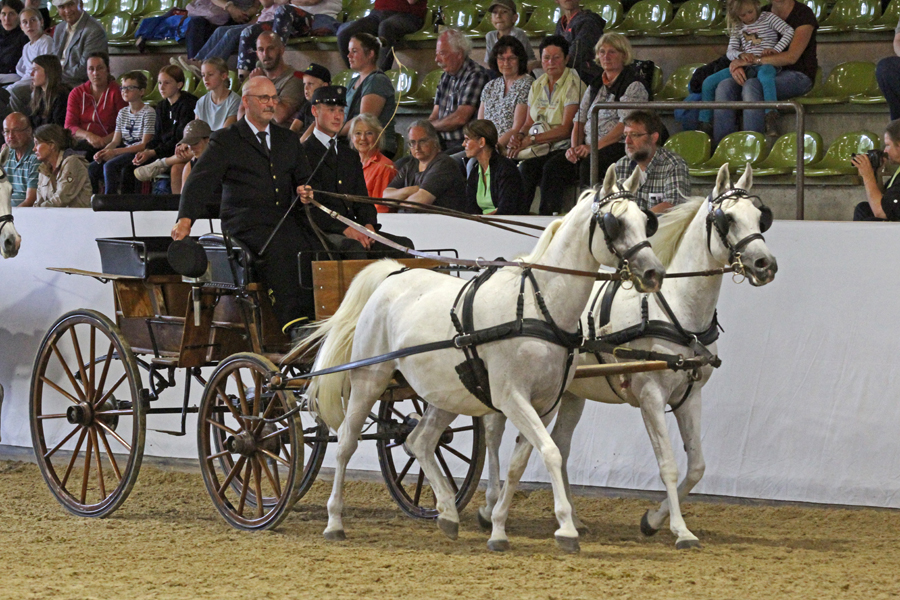 Master of mares Klaus Niethammer driving the Marbach broodmares Dafina (Amurath Muntahi x Dukna) and WM Sahaabah (KP Maryoom x Saadawi).
Master of mares Klaus Niethammer driving the Marbach broodmares Dafina (Amurath Muntahi x Dukna) and WM Sahaabah (KP Maryoom x Saadawi).
Dr. Olms’s position as head of an international publishing house provided many opportunities to promote the Asil Club and its goals. Frequently traveling to the Arab countries for book fairs, he tirelessly forged connections and secured sponsors for the cause of the Asil Arabian. When the renaissance of the Arabian in its homeland began, Dr. Olms did his best to convince the breeders of the importance of Asil blood. He was instrumental in establishing the foundation of what was to become Kuwait’s Bait Al Arab State Stud, founded with and still breeding straight Egyptians, which make up the largest group of Asil Arabians. One of its best foundation mares was bred by Dr. Olms.
The books were and are one part of presenting the Asil Arabian to the public, but not the only one. The other is the Asil Cup International, a very different kind of Arabian show. It is, of course, for Asil Arabians only. The halter classes are deliberately held the traditional way: no make-up, no hard stance, no circling. From among the winners and champions, one supreme champion is elected and awarded the Asil Cup. The “Cup” is actually a beautiful bronze portrait of an important historic Asil Arabian, created by U.S. artist Karen Kasper. The show is not just about halter, though; the emphasis is at least as much on performance. An endurance ride has been an integral part of the event from the start, along with ridden classes as well as ridden displays. Unlike the halter classes, these have always been open to all Arabians.
The very first Asil Cup was held in 1985 at Dillenburg State Stud, followed by eleven more at irregular intervals and in various locations, including a memorable occasion in 2000 at Hannover’s Herrenhausen Gardens during the EXPO World Exhibition. The last Asil Cup to date took place ten years ago at Castell Castle and was the best and biggest yet, with an entire day of ridden competitions, a splendid art exhibition, and probably more spectators than any Arabian show has had during the past 20 years.
Plans for the next Asil Cup have been discussed for several years now, but for one reason or another never came to anything. With the 50th anniversary of the Asil Club coming up this year, the Asil Cup was planned to be held at Marbach State Stud in 2024, which had already hosted the event in 2003. But, in the end, that plan was abandoned in favor of having a grand celebration instead, in conjunction with Marbach’s annual Arabian Horse Days. There would be no show classes, the only competition being the traditional endurance rides. Instead, there would be a three hour show program with presentations of asil horses and other associated displays.
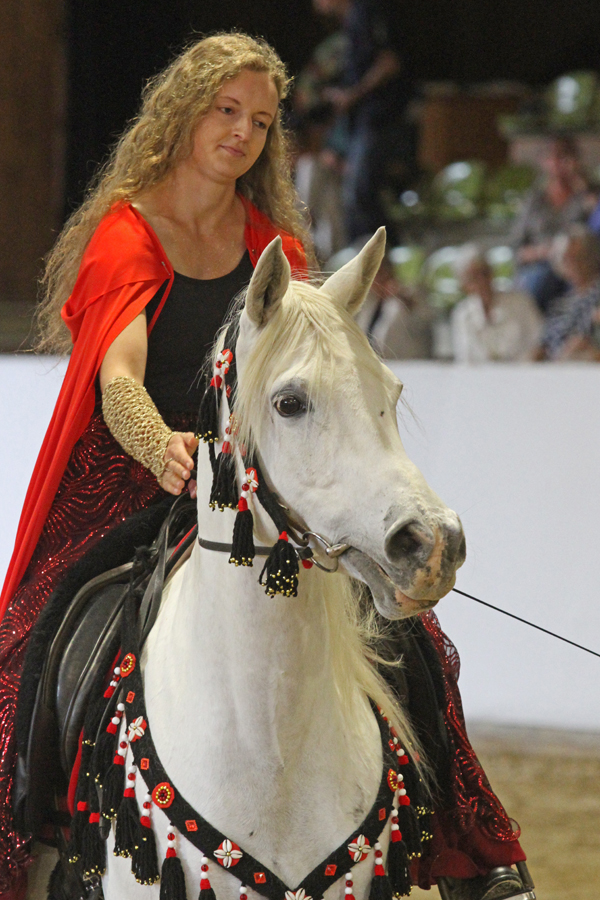 Angela Dorschner-Filsinger and her straight Egyptian mare Sheikha Zafarana (Sheikh Maymoon x Zamala Nabilah), representing 4 generations of Filsinger breeding.
Angela Dorschner-Filsinger and her straight Egyptian mare Sheikha Zafarana (Sheikh Maymoon x Zamala Nabilah), representing 4 generations of Filsinger breeding.
 Salukis bred and shown by the Goebel family, Min Mah Shah Salukis.
Salukis bred and shown by the Goebel family, Min Mah Shah Salukis.
 One of the beautiful falcons from the hawking display.
One of the beautiful falcons from the hawking display.
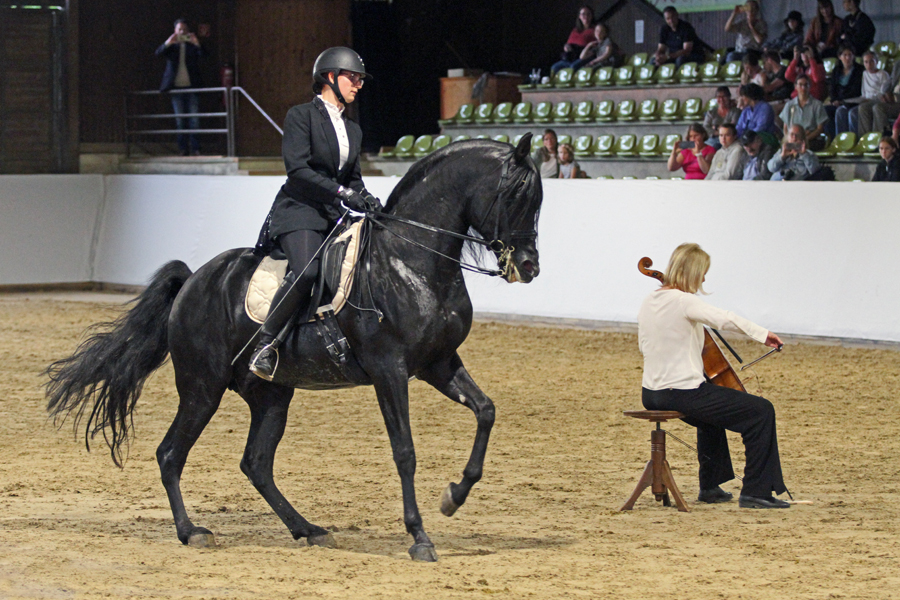 Half-Arabian stallion CP Unico (Fer Diktat x Doctora) dancing to live cello music.
Half-Arabian stallion CP Unico (Fer Diktat x Doctora) dancing to live cello music.
The celebrations started off with a reception and drinks for the Asil Club members in Marbach’s historic tack room on Friday evening, preceding the annual general meeting. Saturday’s program was packed to the gills, starting with the endurance riders setting out in the early morning. During the morning, Marbach presented its broodmares and foals, followed by the German registry’s regional mare and foal inspection and, in the afternoon, the Asil Club’s anniversary show in the indoor arena. During the next four hours, the audience was treated to parades of asil stallions and mares, colorful displays featuring salukis, hawks, and camels, Marbach’s vaulting team, and a variety of ridden displays. Angela Dorschner-Filsinger, granddaughter of foundation breeder Dr. Erwin Filsinger, gave a charming dressage display with her straight Egyptian mare Sheikha Zafarana (Sheikh Maymoon x Zamala Nabilah) in native costume. This mare incidentally represents the fourth generation of Filsinger family breeding and traces to all three of the stud’s foundation mares, Malikah, Nazeefa, and Zabia.
There were also some unique displays, including two men performing Tai Chi with two mares and their foals running free at the same time. How they managed to retain their concentration with the horses careening around them I don’t know, but the mares and foals never once interfered with them and at times interacted so brilliantly you could have thought it was choreographed.
One of the highlights was provided by a Half-Arabian. Unico CP, a magnificent black Hispano-Arabian stallion sired by the straight Egyptian stallion Fer Diktat, performed freestyle dressage accompanied by world-class cellist Eva Freitag of the European Union Chamber Orchestra. Watching the black stallion dance around the musician was simply one of the most brilliant experiences of the day, even more so considering that this horse had never performed in front of an audience before. His owner Claudia Jährig, who also owns several straight Egyptian stallions, later revealed that she had purchased this horse sight unseen during the pandemic (“Something I don’t normally do!”) and how thrilled she was when he stepped off the trailer. It was something of a gamble to bring him, given that it was his first public appearance, but it paid off beautifully. While he was a bit nervous, he never put a foot wrong.
 Livia Jansen and her homebred straight Egyptian stallion DFA Shahir (Shah Tamor x Maylin) accepting their trophy after winning the 44 km endurance ride.
Livia Jansen and her homebred straight Egyptian stallion DFA Shahir (Shah Tamor x Maylin) accepting their trophy after winning the 44 km endurance ride.
 Moushah (Teymur B x Authentic Mouna), straight Egyptian stallion owned by Livia Jansen, who achieved the highest performance test score of any purebred Arabian stallion in 2023.
Moushah (Teymur B x Authentic Mouna), straight Egyptian stallion owned by Livia Jansen, who achieved the highest performance test score of any purebred Arabian stallion in 2023.
 Purebred gelding Saahir (Zahron x Flaxman’s Taraba) with Dr. Daniela Schröder, winner of the 90 km endurance ride and best condition award.
Purebred gelding Saahir (Zahron x Flaxman’s Taraba) with Dr. Daniela Schröder, winner of the 90 km endurance ride and best condition award.
 Kim Heise and her straight Egyptian gelding Hamasa Nizahi (CM Murayh El Era x Hamasa Noufous), winners of the 2024 German National Junior Endurance Championships.
Kim Heise and her straight Egyptian gelding Hamasa Nizahi (CM Murayh El Era x Hamasa Noufous), winners of the 2024 German National Junior Endurance Championships.
 Marbach’s mares running free, led by the straight Egyptians Namrata (DF Malik Jamil x Napirai), left, and WM Nassika (DF Malik Jamil x Nassarina).
Marbach’s mares running free, led by the straight Egyptians Namrata (DF Malik Jamil x Napirai), left, and WM Nassika (DF Malik Jamil x Nassarina).
 Tour group waiting outside Marbach’s 19th century stallion stable.
Tour group waiting outside Marbach’s 19th century stallion stable.
As if having two stallions in the show wasn’t enough, Livia took the opportunity to enter and ride DFA Shahir in his first endurance ride.
“I felt a bit like the white rabbit in Alice in Wonderland,” she recalls the experience. “Somehow, I spent the whole day feeling I was too late. I hadn’t slept all night, and the start was at 5:30. Shahir ran ahead right from the start and soon left the rest of the field behind, he practically flew across those 44 kilometers.
“Later in the afternoon we joined the parade of endurance horses along with some 30 other horses at the Asil Festival. I have never been so proud of him. He is just six years old, but you wouldn’t have known there was a stallion among all the other horses, and he never put a foot wrong when the prizes were given. We’d been in a hurry all day, and we’d made first place.“
That wasn’t all, though. Livia’s other stallion, Moushah, had been shown in the afternoon’s stallion parade. Following the prize-giving, Livia packed up both horses and headed home, where Moushah was due to compete in a dressage competition the next day. Which he did, performing flawlessly against other breeds. That’s how you promote Arabian horses the Asil Club way, and it doesn’t hurt that both stallions are beautiful, typey examples of their breed.
Another endurance horse made an appearance that must have provided great satisfaction to the Asil Club’s founder and president, Dr. Olms. This was Hamasa Nizahi (CM Murayh El Era x Hamasa Noufous), a 9-year-old straight Egyptian gelding who, with his young owner and rider Kim Heise, won the German National Junior Endurance Championships this year. Hamasa Nizahi isn’t just asil, he was bred by Dr. Olms, so he could hardly have won in a more appropriate year!
The festival ended with a gala dinner for Asil Club members and special guests in Marbach’s historic riding hall, where Dr. Matthias Oster presented a slide show on the history of the Asil Club. Most of the original founding members are no longer alive, but it many cases their children were on hand to add their reminiscences, so it was quite a nostalgic and often emotional occasion. To top it all, Dr. Olms was made an honorary member of the German Arab Horse Society.
Those who stayed until the next day were treated to another highlight, a guided tour of Marbach State Stud. Besides learning many fascinating facts about the stud’s 500-year-old history, tour guests are allowed inside the mare and foal barn (normally off limits to visitors) and to get up close and personal with this year’s babies, while head groom Karin Kollmannsberger is on hand to answer questions. The foals, of course, are just as friendly and inquisitive as Arabian foals should be, and as happy to meet people as the people are to meet them.
Fifty years after its inception, the Asil Club now has some 400 members in 40 nations, including the royal stud farms of Saudi Arabia and Bahrain, the studs of the Amirs of Qatar and the Emirates, the Royal Cavalry of Oman, and the state studs of Saudi Arabia, Kuwait, Egypt, and Syria, as well as the Hungarian National Stud Bábolna and of course Marbach with its oldest asil dam line. Whatever the coming years may hold in store, the Asil Arabian is alive and well. It may also, if things go as planned, become part of the UNESCO immaterial cultural heritage. This is something Dr. Olms has been campaigning for over the past few years, and the application is now being processed. If it goes through, it will be yet another reason for celebration!




